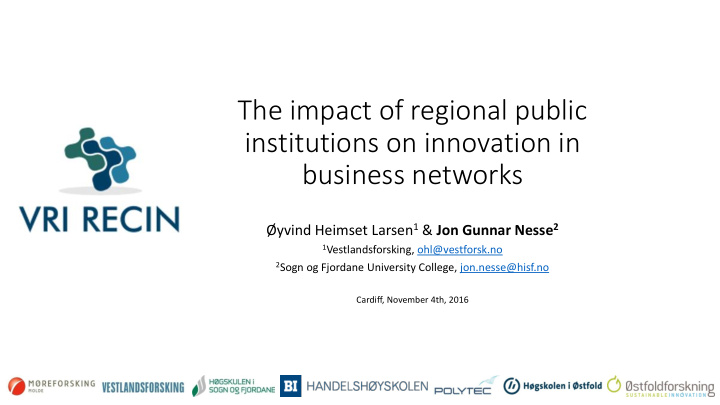



The impact of regional public institutions on innovation in business networks Øyvind Heimset Larsen 1 & Jon Gunnar Nesse 2 1 Vestlandsforsking, ohl@vestforsk.no 2 Sogn og Fjordane University College, jon.nesse@hisf.no Cardiff, November 4th, 2016 08.11.2016 1
Research questions • General topic: Public role in business network building • Our hypothesis is that private sector actors do not necessarily value these public endeavors. To improve the initiatives, stakeholders need a deeper understanding of how they are perceived. • Questions: 1. In what degree do business leaders specifically mention the public role regarding innovation when explaining reasons for joining business networks? 2. How do business leaders interpret the regional public role in network building, and what do they think of the support they get for innovative activities?
OUR CASES GCE Blue Maritime Cluster, Møre Maritime Association, Sogn & Fjordane NCE Smart Energy Markets NCE Maritime CleanTech Norwegian Smart Care Cluster
Three models for relations between Academia-Industry-Government A “statist” model of A ‘‘laissez - faire’’ model A “balanced” model of university – industry – of university – industry – university – industry – government relations government relations government relations (Triple Helix) Etzkowitz & Leydesdorff, 2000; Ranga & Etzkowitz, 2013
Models and government role Model Government role Possible problems Statist Dominating Lock-ins/ path dependency Sub-optimal solutions Laissez-faire At a minimum; regulator and Greater differencies between customer regions TH Active role (e.g. in innovation and Mixture of roles – do businesses entrepreneurship) understand public role?
Functions of business networks Ranga & Etzkowitz (2013): «… the main function of a Triple Helix system … is that of generating, diffusing and utilizing knowledge and innovation.» Fig. 1. The scheme of analysis (adapted from Oltander and Perez Vico, 2005). Bergek, A. et al. (2008). Analyzing the functional dynamics of technological innovation systems: A scheme of analysis. Research Policy , Volume 37, Issue 3, 2008, 407 – 429. Model also recommended by an INERREG IVC analysis report (Heydebreck et al., 2014)
Interviews and data processing Maritime GCE Blue Maritime NCE Maritime NCE Smart Energy Norwegian Smart Association, Sogn & Cluster, Møre CleanTech Markets Care Cluster Fjordane Companies 9 5 9 5 6 Network 2 1 2 1 3 management County municipality 1 1 1 2 1 Other public actors at regional level (IN, 1 2 1 5 3 NRC) Partner responsible Vestlandsforsking, Østfoldforskning, BI Norwegian for interview, Sogn & Fjordane Møreforsking Polytec Østfold University Business School transcribing/ taking College Stavanger, Polytec University College notes and coding All interviews except 8 of 9 interviews 1 were transcribed 2 of 13 interviews All interviews recorded. Separate 4 of 13 interviews from recordings. transcribed from recorded. Notes. notes from two recorded. Notes. Data processing Notes from 1 due to recordings. Coding/ sorting interviewers. Coding/ sorting Coding/ sorting recording failure. according to table 1. Coding/ sorting according to table 1. according to table 1. Coding/ sorting according to table 1. according to table 1.
Results Q1: Most common reasons for businesses to join networks • Meeting place, “connecting people” • Arena for meeting important stakeholders, including representatives of the public sector (County M., IN, NRC) • Motives for meeting public sector: Money and lobbying • Other motives: Money, knowledge/information, relations (investors, lenders, customers, suppliers, etc.) • Reputation/ legitimacy building • Reputation for region, industry and company as part of “something bigger” • Making value creation and workplaces visible • Membership has value in itself • Innovation • Participation in projects (pilots, developing new products) important • No particular public role mentioned • Public roles: Funding, regulating, (part of) organizing networks, participating (in network meetings)
Results Q2: Business leaders ’ view on public roles • Common findings in all the networks • Private actors in the value chain are in the driver's seat in pushing for innovation • Large companies are key members and need to participate • The public sector at the national level was mainly considered an important party • As customer • In funding of projects • As regulator • The public at the regional level and funding agencies are in varying extent considered important • In funding of projects and as network facilitator • Academia is in most networks not considered a crucial success factor for innovation
Conclusion: Government role still like laissez-faire? Govern- ment Indu- Aka- stry de- mia
Recommend
More recommend